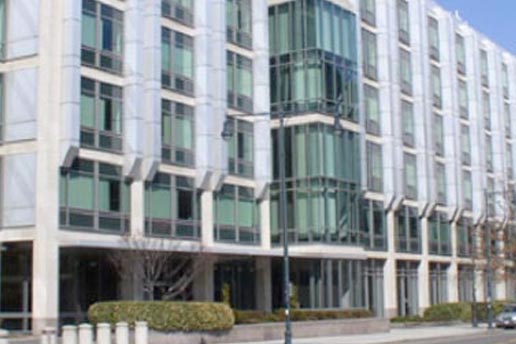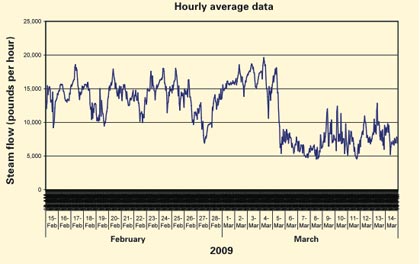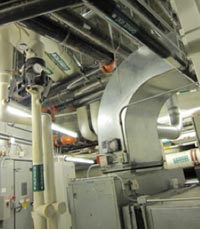
Although energy use can account for up to 70% of an MIT building’s operating cost, exactly where and why that consumption occurs is not obvious. And when a blip in a building’s internal workings can lead to even higher costs, it helps to know what’s going on, energy-wise, around the clock.

Detailed monitoring of the automation system in MIT’s Building 68 showed that heating and cooling were occurring simultaneously in three of the large air-handling units. Programming changes to the building’s automation system on March 5 reduced both steam and chilled water consumption immediately. The reduction in steam use is evident in the chart above. Based on data from the first three months, the annual savings from the reduction in both steam and chilled water use is projected to be more than $360,000. Chart: MIT Department of Facilities
At MIT, Building 68, the biology building, has been the subject of close scrutiny since January 2009. Called continuous commissioning, or data-based commissioning, this monitoring is an ongoing process to resolve building operating problems, improve comfort, and optimize energy use.
“Computer analysis of building data points out operating patterns that fall outside of a determined tolerance level and recommends the affected system components for study by an engineer,” says Peter Cooper, manager of sustainability engineering and utility planning. “In this manner, large amounts of data can be evaluated and sifted to allow us to identify potential energy savings opportunities.”
In the Building 68 pilot project, the pay-off has been significant. In the current fiscal year, more than $3.1 million of the building’s $4.5 million operating expense has been for steam, chilled water, and electricity. Based on the first three months of monitoring, annual savings from changes in Building 68 alone are projected to top $360,000.
“This is part of a larger-scale effort coordinated by the MIT Energy Initiative Campus Energy Task Force of greening the MIT campus. The project encompasses facility improvements, student projects, and individual measures by the entire MIT community to increase energy efficiency,” says Leon R. Glicksman, professor of building technology and mechanical engineering and co-chair of the Campus Energy Task Force.
“We plan to carefully monitor the energy savings as well as economic payback to inform future measures on campus and provide guidance for other organizations facing the same challenges,” he says.
Running hot and cold
Building 68 keeps its laboratories up and running and its occupants comfortable with the help of seven air handlers, two heat exchangers, chilled and hot water pumps, fan coil units, and variable air volume boxes, which help make air-conditioning systems more efficient by regulating the amount of cooling targeted toward specific rooms or areas. All these components represent a lot of complexity, which translates into opportunities for things to go wrong—which is what happened sometime before March 5.
MIT had enlisted the help of Cimetrics, a Boston-based pioneer in building optimization, to install a system that delivers building data over the Internet. Thanks to Cimetrics’ monitoring of key operating parameters—541 data points in the building’s automation system are read and analyzed every 15 minutes—building operators could see that heating and cooling were occurring simultaneously in three of the large air-handling units.

Typical large heating, ventilating, and air-conditioning equipment that is monitored, analyzed, and optimized by continuous commissioning. Photo: Amanda Graham, MITEI
Programming changes to the building’s automation system fixed the simultaneous heating and cooling problem, leading to an immediate, dramatic drop in both steam and chilled water use. Repairs to valves and valve operators boosted the poor performance of a heat recovery system—also identified by the data monitoring—and Cooper predicts that setting back heating and cooling temperatures when the building is unoccupied will result in additional savings.
“As energy gets more expensive and retrofits get more complicated, building owners want to know just how their investment in HVAC or lighting controls is paying off in terms of lower operating costs and higher energy savings,” says Walter E. Henry, MIT Department of Facilities’ director of engineering. “So far, we have applied monitoring technology to Buildings 18, W35, E25, and most recently, 16 and 56. We plan to work our way through other lab buildings, which are the highest energy intensity and most complex of the Institute’s buildings.
“We are also incorporating this capability into new construction—the new graduate residence NW35, the new Media Lab and Sloan buildings, the David H. Koch Institute for Integrated Cancer Research—as a performance verification tool during the warranty period and beyond,” he says.
Assessing three months of Building 68’s utility billing data led to a reduction of 5,047 pounds per hour of steam and 275,910 tons per hour of chilled water from April to June 2009 over the same period in 2008. “We will save more than $360,000 over 12 months if gas prices remain at the current level,” Cooper says. “Building 68 was a continuous commissioning success, and we’re looking forward to repeating this kind of success story around campus.”
This article appears in the Autumn 2009 issue of Energy Futures.
Press inquiries: miteimedia@mit.edu